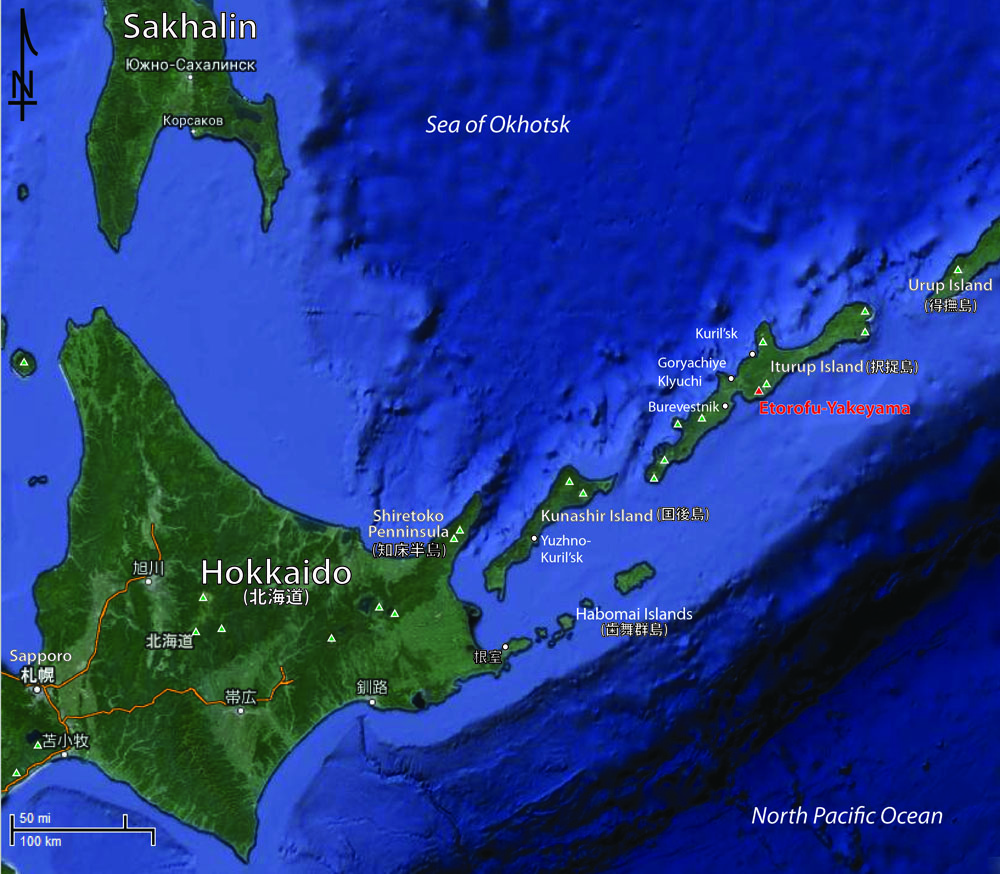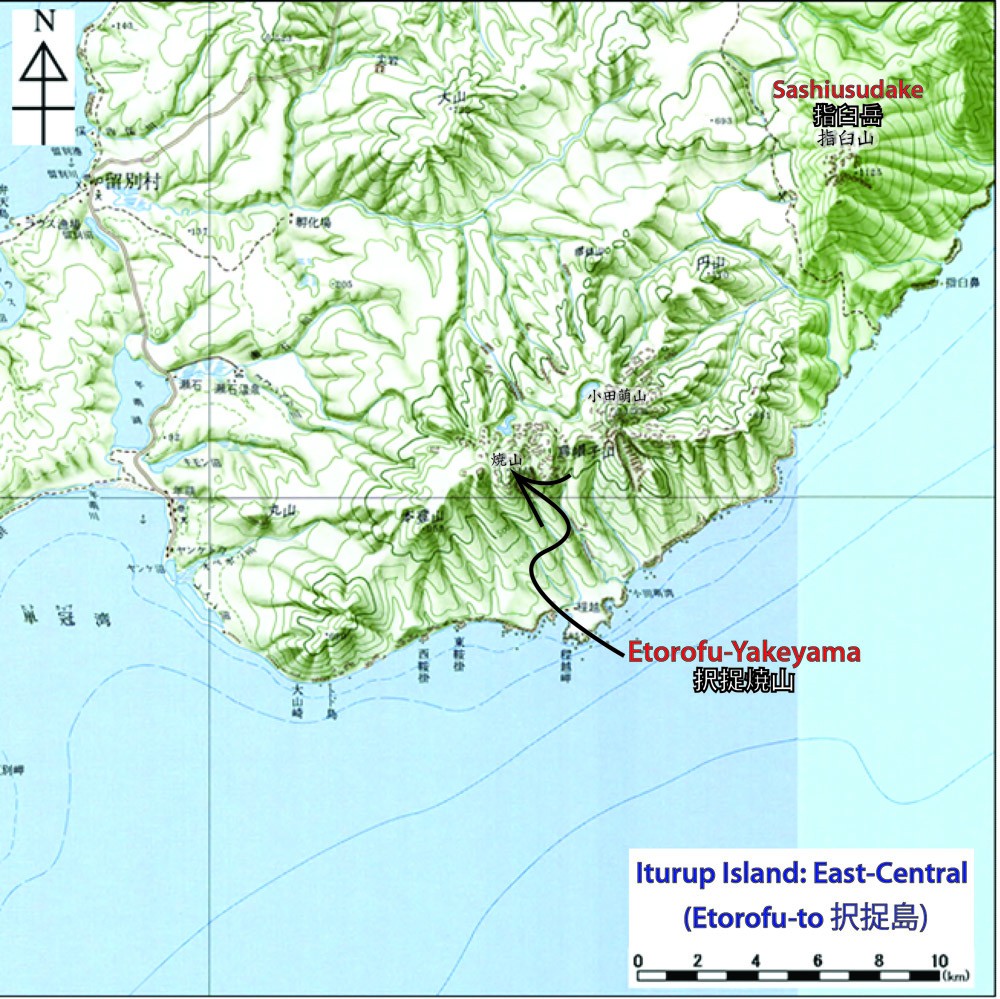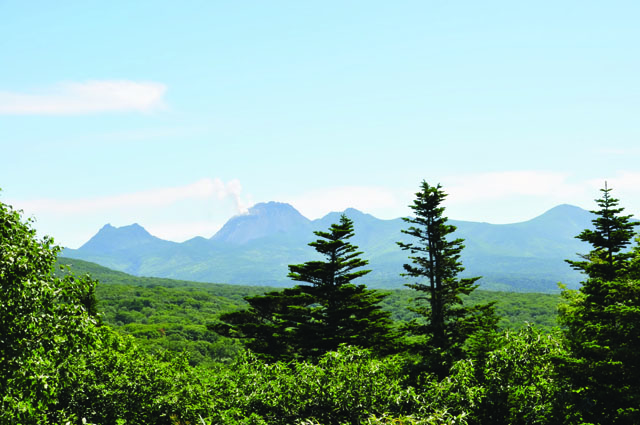Report on Etorofu-Yakeyama [Grozny Group] (Japan - administered by Russia) — April 2014
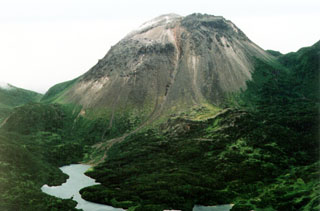
Etorofu-Yakeyama [Grozny Group]
Bulletin of the Global Volcanism Network, vol. 39, no. 4 (April 2014)
Managing Editor: Richard Wunderman.
Etorofu-Yakeyama [Grozny Group] (Japan - administered by Russia) 23 years of quiet ended by occasional minor 2012-2013 eruptions
Please cite this report as:
Global Volcanism Program, 2014. Report on Etorofu-Yakeyama [Grozny Group] (Japan - administered by Russia) (Wunderman, R., ed.). Bulletin of the Global Volcanism Network, 39:4. Smithsonian Institution. https://doi.org/10.5479/si.GVP.BGVN201404-290070
Etorofu-Yakeyama [Grozny Group]
Japan - administered by Russia
45.012°N, 147.871°E; summit elev. 1158 m
All times are local (unless otherwise noted)
Etorofu-Yakeyama (Ivan Grozny or Grozny Group) rests on E-central Iturup Island (known as Etorofu-to in Japanese and Ostrov Iturup in Russian) (figures 4 and 5). An andesitic lava dome forms the peak, and the complex also includes a ~3-3.5 km long caldera open to the S. The complex erupted multiple times during 1968-1989. Several minor eruptions occurred during 2012 and 2013. Our previous report (BGVN 17:12) described a 3 May 1989 eruption. The Japan Meteorological Agency (JMA), the Tokyo Volcano Ash Advisory Center (VAAC), and the Sakhalin Volcanic Eruption Response Team (SVERT) were primary sources for this report discussing events as late as April 2013 with no further notice of eruptions through July 2014.
2012 eruptions. According to SVERT, Etorofu-Yakeyama erupted on 16 August 2012, for the first time since 1989. The plume from the lava dome inside the caldera resulted in light ashfall in the Goryachiye and Kuril`sk settlements (to the N; figure 4). JMA reported the eruption started on 15 August and ended on 26 August 2012 as noted in table 1. Based on MTSAT-2 satellite images, JMA noted an ash plume reached 4 km altitude on 25 August. The Tokyo VAAC issued a Volcanic Ash Advisory (VAA) on 25 August. No additional ash observations were issued after 25 August 2012.
Table 2. A synopsis of eruptions that took place at Etorofu-Yakeyama during 1968-2012. Taken from the JMA website.
| Year | Phenomenon | Activity, damage, etc. |
| 1968 | Eruption | February 1968. |
| 1970 | Eruption | -- |
| 1973 | Eruption Explosion |
Small explosion at summit crater in early January. Series of strong explosions at summit crater on 16 May and formation of a large crater. |
| 1989 | Explosion | Explosions during 3-14 May, 19 June, and early August with a volcanic plume 2 km high. |
| 2012 | Eruption | Eruption during 15-26 August with a plume 4-5 km high. |
On 16 August 2012, F. Greenberg, a Sakhalin Region Emergency Ministry representative, reported that gas emissions on the NE slope had increased on 14 August which suggested unrest. Hokkaido University researchers associated with JMA visited Etorofu-to Island and reported eruptive activity started on 15 August.
Four eruptions occurred during 25-26 August. One plume rose 4-5 km. Figure 6 shows the volcano erupting on 25 August 2012. The next day in the same general area the researchers reported fumarolic activity on the NE side where the ash plume vented (figure 7). SVERT reported during 23 August-3 September increased fumarolic activity at Etorofu-Yakeyama. The Aviation Color code during that interval was Yellow.
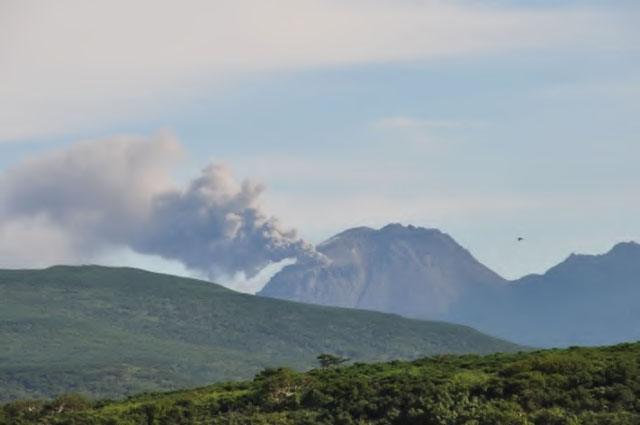 |
Figure 7. Etorofu-Yakeyama seen during an eruption as viewed from NW on 25 August 2012. Courtesy of JMA and Hokkaido University. Photo by M. Nakagawa. |
2013 eruptions. Ash fall was reported several times during February-April 2013. SVERT reported that on 16 February, a gas and ash plume rose to an altitude of about 3 km. Tokyo VAAC reported a possible eruption occurred on 29 March. The possible ash plume rose to 2.1 km and drifted E.
On 3 April 2013 an eruption took place that was later reported by Interfax, Russia & FSU General News. 2-3 mm of ash was deposited on Kuril`sk and other settlements. Plume height was not recorded due to cloud cover in the area. On 4 April, the Tokyo VAAC detected an ash plume with an altitude of ~3 km drifting W and NW in satellite images. No additional ash observations were issued after 4 April 2013.
Geological Summary. The Etorofu-Yakeyama (Ivan Grozny) complex is located in the center of Iturup Island. It has a 3-3.5 km diameter caldera open to the south, where a large extrusive andesitic dome was emplaced. Several other lava domes of Holocene age were constructed to the NE; extrusion of these domes has constricted a former lake in the northern side of the caldera to an extremely sinuous shoreline. Recorded eruptions, the first of which took place in 1968, have been from the central Yakeyama (Grozny) dome.
Information Contacts: Japan Meteorological Agency (JMA), Otemachi, 1-3-4, Chiyoda-ku Tokyo 100-8122, Japan (URL: http://www.jma.go.jp/); Tokyo Volcanic Ash Advisory Center (Tokyo VAAC) (URL: https://ds.data.jma.go.jp/svd/vaac/data/); Sakhalin Volcanic Eruption Response Team (SVERT) (URL: http://www.imgg.ru/en/svert.html); EMERCOM Crisis Management Centre (URL: http://en.mchs.ru/Forces_and_Facilities/National_Emergency_Management_Centre); Sakhalin Institute of Marine Geology and Geophysics Institute of Marine Geology and Geophysics FEB RAS (IMGG FEB RAS), 693022, Russia, Yuzhno-Sakhalinsk, Nauki str. 1B (URL: http://www.imgg.ru/); RIA Novosti (URL: http://en.rian.ru/); Itar-Tass (URL: http://tass.ru); and Interfax, Russia, & FSU General News (URL: http://connection.ebscohost.com).

